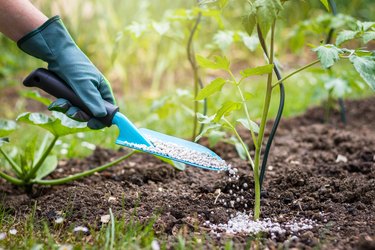
Like all living things, lawns need the right amount of nutrients to be healthy and look their best. While lawns get most of the nutrients they need from the soil, it's not always enough for them to thrive, so lawn owners need to apply fertilizer.
For most lawns, applying fertilizer only needs to be done a few times per year, but it needs to be done properly. Experts recommend using a spreader, either a push-powered rotary or drop spreader for larger lawns or a hand-held spreader for smaller areas. Applying lawn fertilizer by hand is also an option, but it comes with the risk of uneven lawn fertilizer application, so it must be done with extra care.
Video of the Day
Video of the Day
Choose the Right Fertilizer
All lawns and soils have unique nutritional needs, so it's important to figure out the ideal type of fertilizer for your lawn. Conduct a soil test using an at-home kit or a mail-in service and the results will tell you what ratio of nitrogen (N), phosphorus (P) and potassium (K) to look for in a fertilizer. If you intend to spread fertilizer without a spreader or other tool, choose a slow-release granular fertilizer, which comes as small pellets. Many different brands are available, including organic and synthetic options plus some that include weed control.
Calculations for Even Application
Avoid uneven lawn fertilizer application and get the best results by starting with a few simple calculations. First, figure out the square footage of your lawn area. This generally involves measuring the side edges of the lawn and following the standard formula for the area of a square, rectangle or triangle; organic shapes might require some guesswork along with a diagram.
For every 1,000 square feet of lawn, you should apply 1 pound of nitrogen, which is the first figure of three (N-P-K). Look on the packaging to find the percentage of nitrogen contained in your particular fertilizer. Divide 100 by this figure and the result is how much fertilizer (in pounds) is needed for every 1,000 square feet of lawn. Divide the total square footage of your own lawn by 1,000 and multiply the result by the pounds of fertilizer needed for 1,000 square feet of lawn. This gives you the approximate weight of fertilizer you need to apply it evenly across your lawn.
When to Apply Lawn Fertilizer by Hand
The ideal times of year to apply lawn fertilizer depend on where you live and the type of grass you have. The most important time for application is during the most active growing season.
If you live in the Northern half of the United States and have cool-season grass, this is early fall; in the South with warm-season grass, it's summer. Many lawn owners also apply fertilizer in spring. Winter applications are generally unnecessary.
Check the weather forecast before you spread fertilizer without a spreader (or with one). Make sure no rain is predicted for the next few days and also avoid fertilizing immediately after a rainstorm. Avoid applying lawn fertilizer by hand when it's windy, as this can result in uneven lawn fertilizer application. Also do not apply it when it's sunny, as this can burn the grass. Spread fertilizer in the early morning or evening or on a cloudy day.
Preparation for Fertilizing a Lawn
Prepare by mowing, raking and watering the lawn a few days before you intend to fertilize it. Before applying fertilizer by hand, put on gardening gloves, protective goggles, long sleeves, pants and a dust mask, as fertilizer can be harmful to the skin, eyes and lungs. Read the fertilizer manufacturer's instructions thoroughly. Measure the appropriate amount of product in a bucket, working over a driveway, patio or other concrete surface away from the lawn in case of spills.
For the best way to spread fertilizer by hand to avoid uneven lawn fertilizer application, you might divide the total amount of fertilizer in half, in quarters, or in smaller divisions. Divide the lawn area visually or by using some sticks or other markers to help you apply the total quantity of fertilizer evenly across the area.
How to Apply Lawn Fertilizer by Hand
It is challenging to spread fertilizer without a spreader, so work slowly, carefully and deliberately to spread the product as evenly as you can across the lawn. Walk first around the perimeter of the lawn, sprinkling handfuls of fertilizer granules over the grass in front of you. One way to apply it evenly is to sprinkle one handful per step or two steps and try to keep the size of your steps even and the area in which you spread even with each step. After completing the perimeter, cover the interior part of the lawn first by walking in consecutive horizontal lines and then by walking in vertical lines.
Follow the fertilizer application with a light raking to help spread the product evenly and let it settle into the soil. The instructions on your fertilizer package will tell you whether or not a light watering is required following application.